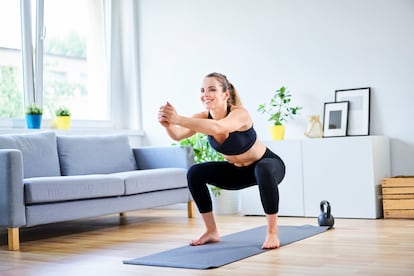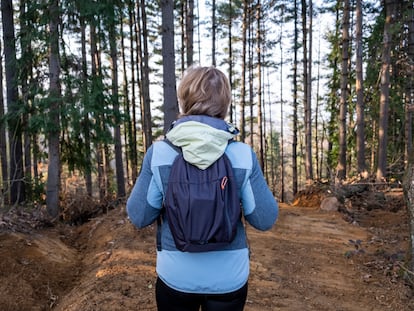The squat: instruction manual for a basic exercise
One of the world’s leading experts, physiotherapist Aaron Horschig, PhD, says you should master the movement patterns of this effective workout to develop your leg muscles

Check out a baby as it begins to walk, or a little girl playing on the floor at home. We do squats constantly, from a young age. They’re a natural movement. Now think about it, how many times a day do you get in and out of a chair? Do you ever bend down to pick up objects from the floor?
Exercises related to the movements of our daily activities are of great interest within the world of physical exercise development and research. The squat has components of everyday functional movements, like walking, climbing, going down stairs, sitting and standing. Studies show how proper stance width and foot placement angles should be chosen, according to the ranges of motion of specific joints (knee, hip or ankle).
Aaron Horschig, a doctor of physical therapy and a strength and conditioning coach, dedicates his work to helping find procedures that not only reduce training-related aches and pains, but help users — regardless of their physical condition — to discover their true potential.
As the author of the book The Squat Bible and founder of SquatUniversity.com, Horschig has successfully adapted his techniques towards improving athletic performance among the general population. As he explains in his book, “Without mastering the simplest movement patterns, there is no way to reach the maximum physical potential Socrates wrote about. Until we alter our perspective and become experts when it comes to our physical bodies, and move better before we try to move more, we will continue to fall short of our potential. And we will continue to see injuries increase. All of these changes start with the squat.”
Research has shown that the squat is an effective exercise in the development of the hip, knee and ankle muscles. Now, the question is: How to do it correctly? “A good squat has three factors: the feet remain stable, with the body weight distributed over the placed tripod, the knees remain aligned with the feet (no sinking of the knees) and the torso remains stable, without any excessive movement of the spine.”
Debunking myths
There are all kinds of superstitions when it comes to when to include and how to execute this exercise in the gym. Our expert unpacked them. Here are some examples:
“If you go deep, your knees will hurt”
This is one of the phrases one hears the most in gyms, and is invoked by both clients and some professionals. According to the expert: “Deep squats do not hurt the knees, when executed with proper technique, planning and adapting the appropriate loads for a specific training period. The body can handle this impact very well, and without great risk of injury. When improper technique and/or the use of too much weight — more than a person can handle — comes into play, the risk of getting hurt increases.
“Knees should extend beyond the toes”
As Horschig points out, “Science has shown that the knees of healthy athletes are relatively safe when performing a deep squat. There is no denying this research. As long as excessive loads are limited and good technique is used, the knees can and should move beyond the toes at the bottom of a squat to allow to hips to drop fully.”
When you’re squatting, you should respect the established technique — but what is the proper technique?
When it comes to training, many athletes ask the following question: should toes be facing forward or at an angle? “There is no single position that is better than any other when it comes to toe angle. However, most people should perform barbell squats with their feet facing outward between 10 and 30 degrees as a general recommendation. Always use the position that is most comfortable for your body. Your musculoskeletal system talks, it sends signals: if something hurts, don’t do it. Exercise should not cause discomfort or pain. Remember: no two squats look exactly alike. This is normal. You and your friend are expected to adopt different postures when lifting the bar,” explains the expert.
The ankle and its great, underestimated power
Squats are a complete exercise, involving hip mobility, but also that of your ankle. The latter is often overlooked. As Horschig admits, “Ankle mobility limitations are almost the number one problem hindering good technique.” The author clarifies the following: “If you want to do a good deep squat, your knee has to move forward over the toe, that requires mobility in the ankle. So, if you have range limitations (range of motion in the joint), your chest is going to fall forward.” You might note a suggestion to work on ankle mobility exercises here.
At the gym, as in life, doing squats is what in fashion would be call a must, a basic. We do them without realizing it in a number of our everyday actions. As Horschig recounts in The Squat Bible: “When we talk about the squat, many people often want to jump right into discussing the barbell squat. We forget the basics of the bodyweight squat. If we don’t address the movement of the squat before the exercise version of the squat, we set ourselves up for failure. If we can fix the issues that present themselves during the bodyweight squat, we give ourselves a greater capability to carry the load of the barbell. We should all have the ability to perform a full-depth ‘ass-to-grass’ squat without any weight. Period. We all want to live, play, and compete in a pain-free manner for as long as we live. This starts with learning how to squat correctly with the bodyweight movement.”
In this sense, our specialist is clear on what advice he’d give to those looking to train and squat correctly: “Take your time and don’t rush with the weight. Always focus on form before adding load.”
Sign up for our weekly newsletter to get more English-language news coverage from EL PAÍS USA Edition
Tu suscripción se está usando en otro dispositivo
¿Quieres añadir otro usuario a tu suscripción?
Si continúas leyendo en este dispositivo, no se podrá leer en el otro.
FlechaTu suscripción se está usando en otro dispositivo y solo puedes acceder a EL PAÍS desde un dispositivo a la vez.
Si quieres compartir tu cuenta, cambia tu suscripción a la modalidad Premium, así podrás añadir otro usuario. Cada uno accederá con su propia cuenta de email, lo que os permitirá personalizar vuestra experiencia en EL PAÍS.
¿Tienes una suscripción de empresa? Accede aquí para contratar más cuentas.
En el caso de no saber quién está usando tu cuenta, te recomendamos cambiar tu contraseña aquí.
Si decides continuar compartiendo tu cuenta, este mensaje se mostrará en tu dispositivo y en el de la otra persona que está usando tu cuenta de forma indefinida, afectando a tu experiencia de lectura. Puedes consultar aquí los términos y condiciones de la suscripción digital.
More information

Exercising to maintain bone health through menopause
Últimas noticias
The murder of Michele and Rob Reiner: A tale of horrific days in Hollywood
Trump orders a ‘complete blockade of sanctioned oil tankers’ going to and from Venezuela
Not all insomnia is the same: Study identifies five subtypes and paves the way for personalized treatment
The United States designates Clan del Golfo as a foreign terrorist group
Most viewed
- ‘El Limones’ and the growing union disguise of Mexican organized crime
- Christian Louboutin: ‘Young people don’t want to be like their parents. And if their parents wear sneakers, they’re going to look for something else’
- ‘We are dying’: Cuba sinks into a health crisis amid medicine shortages and misdiagnosis
- A mountaineer, accused of manslaughter for the death of his partner during a climb: He silenced his phone and refused a helicopter rescue
- The low-cost creative revolution: How technology is making art accessible to everyone










































